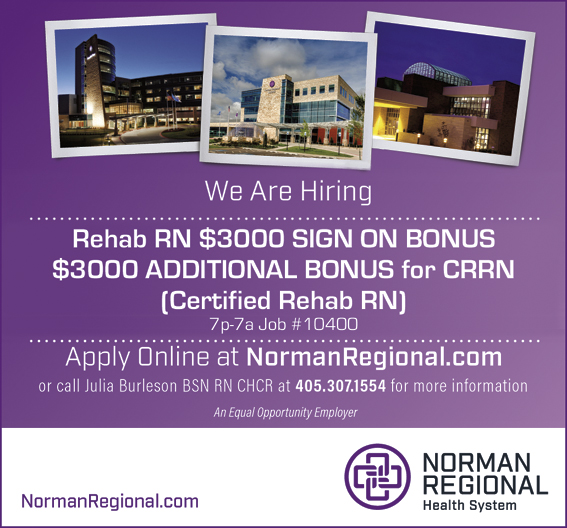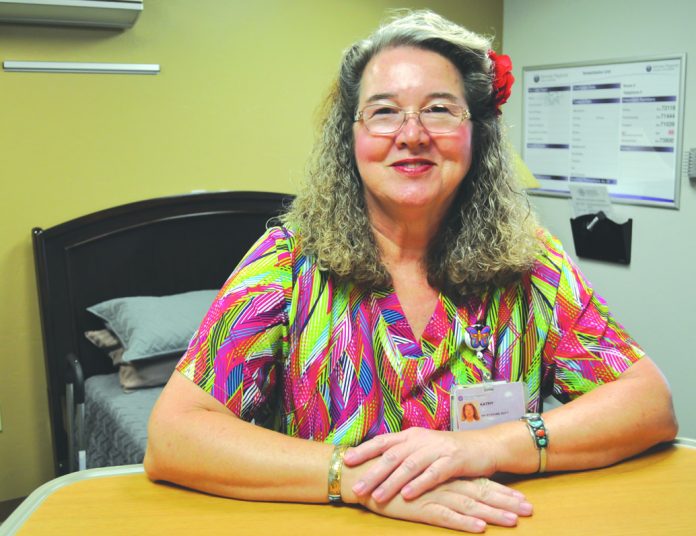by Bobby Anderson, RN, Staff Writer
For more than 40 years, Kathy Smith, RN, MSN, CRRN worked in critical care.
Taking care of and doing for her patients was all she had ever known.
But the next chapter of Smith’s nursing career would lead her into rehabilitation nursing and a change that would make her head spin.
“It was almost a year to get (critical care) out of me,” Smith laughed.
Now the nurse manager for The Rehabilitation in the Norman Regional Health System, Smith is looking for nurses to share in the kind of career resurgence she experienced.
“I probably have seen more of an integrated team in rehab than in med/surg or critical care,” Smith said. “Over there the nurse feels like it’s all me. In rehab it’s not, it’s physical therapy, speech, OT, the neuropsychologist.”
Smith is actively searching for certified rehab nurses.
The rewards in rehab nursing are both instant and long-term. Helping patients make those incremental improvements each day provide instant gratification.
Seeing them come back for the yearly Christmas party or just stopping by to say thank you bring all those feelings back.
“You really can establish relationships here and you want nurses that want to do that,” Smith said. “They’re not just in and out. Our average stay right now is about 10 days. Then you have those that are here about a month.”
“It’s a neat thing for us to see we were a part of that person’s recovery.”
Motivation and behavior modification are hallmarks of rehab nursing. Letting the patient do as much as they can while teaching them along the way to independence is vital.
“In rehab it really does take a more specialized rehab nurse to understand we need to mimic with the patient exactly what we want them to do at their house,” Smith said. “I’m trying to recruit nurses who really have a lot of patience and know you have to give them time to do what they need to do. You can’t rush them.”
“It’s all about teaching.”
Smith’s nurses see a range of patients from traumatic brain injuries and strokes to falls at home or other accidents.
“Most of the people who come to rehab have had a life-changing experience,” Smith said. “So many of these people have to be motivated. You have to have that nurse in rehab that can help that person become motivated.”
The majority of Smith’s career has been spent doing what patients could not.
Now her and her nurses spend their time restoring patient’s to their former lives.
Earning her CRRN designation solidified for her that she was indeed in a unique nursing field.
“I didn’t realize that until I got into it and then I saw why,” Smith said. “I’ve noticed after being in critical care you have more aggressive, assertive people in critical care. When I got to rehab I noticed the type of nurse here is more soft about what they do. They’re more patient about letting them do it. We’re taught as nurses to do everything for the patient.
“You get over here in rehab it’s different, it’s more therapy. You’re supposed to let them do as much as they can.”
One of the advantages Smith’s staff enjoys is being inside the hospital.
“You get a lot of support in the hospital especially from the (Medical Intervention Team) they’re a lifesaver,” Smith said. “We don’t want patients to code over here and rarely do we have a code. Now we also have the hospitalists over here and you have that support as internists for you. You also get the support of the nephrologists, the neurologists – plus the ER is right here.”
The Rehabilitation Center is designed to provide the highest quality care possible.
It is accredited by the Commission on Accreditation of Rehabilitation Facilities (CARF) for the Adult Inpatient Rehabilitation program and the Stroke Specialty Program with an established pattern of excellence.
Smith said the facility participates in a rigorous CARF review every three years to maintain this accreditation.
The center’s 2017 scores show it’s making a difference for patients:
* 99 percent of patients say they would recommend The Rehabilitation Center to others.
* 97 percent of patients ranked The Rehabilitation Center as a 9 or 10 out of 10 compared to other rehabilitation centers.
* 80 percent of patients who were discharged from The Rehabilitation Center were able to return to an independent living setting.
* The average length of stay for a patient is 12 days.
The rehabilitation team includes:
* Rehabilitation physicians
* Rehabilitation nurses
* Physical therapy
*Occupational therapy
*Speech therapy
*Dietary services
*Social work and case management
*Psychology services
*Respiratory therapy
*Pharmacy
*Admission liaison

Rehab RN $3000 SIGN ON BONUS
$3000 ADDITIONAL BONUS for CRRN (Certified Rehab RN)
7p-7a Job #10400
Apply Online at NormanRegional.com
or call Julia Burleson BSN RN CHCR at 405.307.1554 for more information
An Equal Opportunity Employer
Norman Regional Health System
NormanRegional.com












